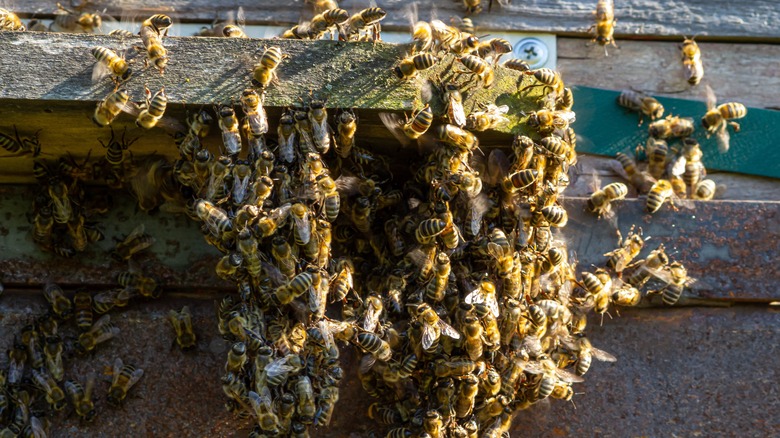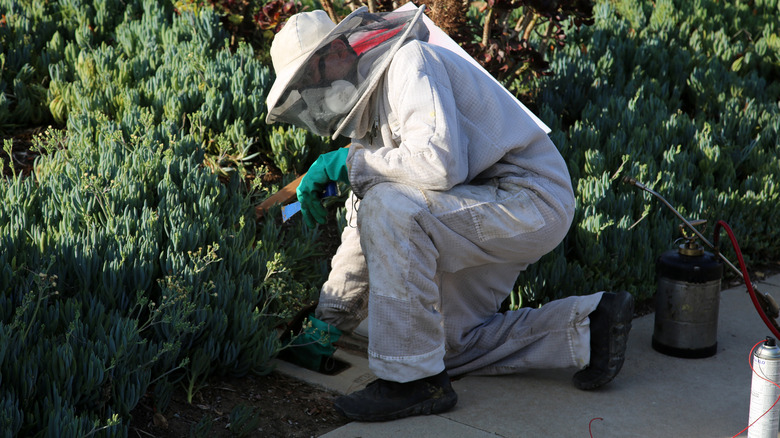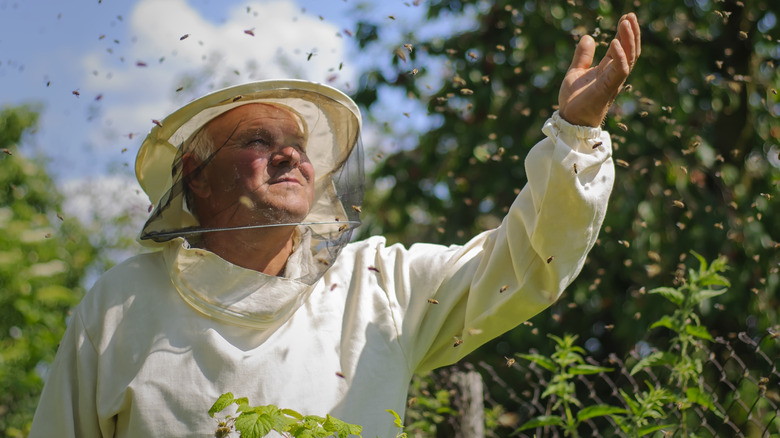An Expert Explains The Safest Way To Remove A Beehive From Your Home's Exterior – Exclusive
There's quite a bit of misunderstanding about bees, such as when they are dangerous and when not, as well as what to do if you have them on your property. Whether you have an intricately structured honey hive hanging from a tree or an incognito nest buried underground, one thing most people don't want is to be stung. Bees tend to be less likely to sting than other types of flying insects, such as more aggressive wasps and hornets, according to NYC Health. Generally speaking, bees are peaceful, until they feel threatened that is, which can happen when a person tries to wave them away, for example.
Simple, unintentional actions can create a risk of being stung, and that's why it's important to get rid of bees on your property. If you do have one you need to deal, it's important not to swat it down or use pesticides. Instead, follow these insights from Paul Dinham, a bee conservation expert with Bee Life. In an exclusive interview with House Digest, he explains how to safely remove a beehive in the most humane way possible.
Call the experts
Dealing with a beehive is not the time to get out the hose or to attempt to swat it down, because doing that will simply anger its inhabitants. As Paul Dinham explains, "Removing a beehive from your property can be a difficult and dangerous task. The best way to remove a beehive from your home's exterior is to contact a bee expert." To be clear, a bee expert isn't necessarily an exterminator, but rather a highly trained professional who understands the inner workings of the hive.
Noting that bees are critical to the environment and they are in danger, as confirmed by the Soil Association, it may be best to relocate the hive if that's an option. Dinham recommends letting a professional do this, stating, "They will have the necessary equipment and experience to safely relocate and remove the hive. This is the best option if you want to avoid harming the bees or causing any danger to your property."
Be properly prepared
If you're not able to hire a professional to do it, there are some key recommendations from Dinham to keep in mind before taking on this task. "Make sure that you have the proper protective gear to avoid being stung. Bees will only attack if they've been provoked or when they are defending their hive," he says. The less overall agitation to the hive, the better for the bees and for you.
First, you'll need to locate the actual hive. NYC Health states that they are commonly found underground or located in trees or plant stalks. In some situations, they'll be hiding within buildings or structures, including on light poles around the property. "Once you have found the hive, you will need to decide how you want to remove it. You can relocate the hive. [To do so,] you will need to find a new area for it that is away from your home," advises Dinham. Look for similar structures that can provide stability for the hive. Dinham adds, "Once you have found a new place, you will need to transfer the bees and the hive to the new location."
Use humane substances
Harsh chemicals that pollute the planet are not necessary when dealing with bees. Dinham recommends a more humane approach using garlic spray instead. To make your own, he says, "First, crush a few cloves of garlic and mix them with water. Then, spray the mixture around the nest. The strong smell will force the bees to leave their hive. You can then remove the hive and dispose of it." That's a simple and direct way to get results.
There are other techniques as well. Per Dinham, "You can also use cinnamon. Sprinkle cinnamon around the hive each day for around a week. The smell sends the bees in search of a place to relocate, and the bees will build a new hive away from your home's exterior."
Thanks to simple, natural methods like these, it's possible for you to keep bees away without resorting to chemical-based pesticides that will bring harm to the bees or the earth itself.



